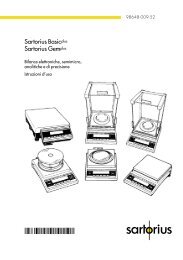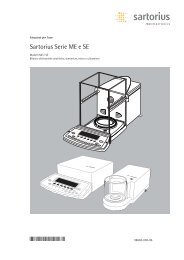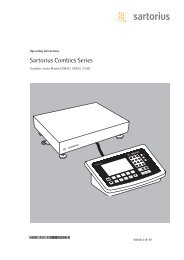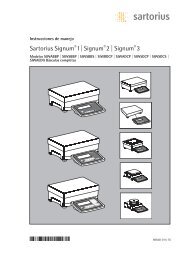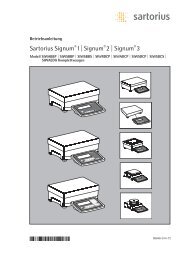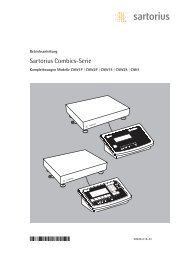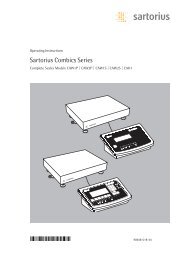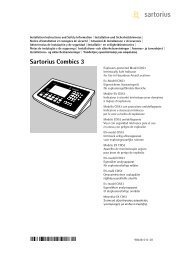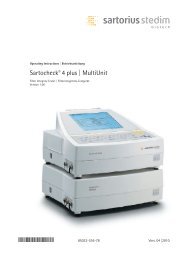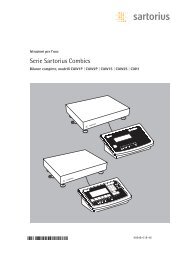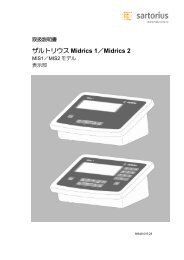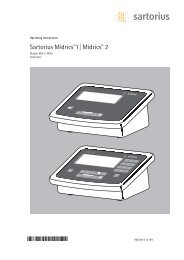VG TuFlux SLO5705-e12043_85032-540-28.indd - Sartorius AG
VG TuFlux SLO5705-e12043_85032-540-28.indd - Sartorius AG
VG TuFlux SLO5705-e12043_85032-540-28.indd - Sartorius AG
You also want an ePaper? Increase the reach of your titles
YUMPU automatically turns print PDFs into web optimized ePapers that Google loves.
Validation Guide<br />
<strong>TuFlux</strong>® SIL – Silicone Tubing
Table of Contents<br />
1. Introduction 4<br />
1.1 Security of Supply 5<br />
1.2 cGMP Quality Assurance from<br />
<strong>Sartorius</strong> Stedim Biotech 5<br />
1.3 Quality Assurance 5<br />
1.4 Complete Traceability 5<br />
1.5 Quality Management System 5<br />
1.6 Human Resources 5<br />
1.7 Infrastructure 5<br />
1.8 Purchasing 6<br />
2. Technical Specifications 7<br />
2.1 Tubing Manufacturing 7<br />
2.2 Tubing Dimensions 7<br />
2.3 Type and Part Numbers Overview 7<br />
2.4 Material of Construction 8<br />
2.5 Physical Properties 9<br />
2.6 Physico Chemical Test 10<br />
2.7 Chemical Compatibility 12<br />
2.8 Biocompatibility 14<br />
2.9 Tubing Printing 15<br />
2.10 Extractable Profile 15<br />
2.11 FT-IR and DSC Profiles 16<br />
2.12 Sterilization Compatibility 17<br />
2.13 Shelf Life and Recommended<br />
Storage Conditions 17<br />
3. Functional Qualification Tests 18<br />
3.1 Burst Pressure Test 18<br />
3.2 Pumping Life Time 19<br />
3.3 Clamping Test 19<br />
3.4 Clamping Force 19<br />
3.5 Barrier Properties to Water Vapor 20<br />
3.6 Oxygen Permeability 21<br />
3.7 Flow Rate Data 21<br />
| 3
1. Introduction<br />
4 |<br />
<strong>Sartorius</strong> Stedim Biotech bags and<br />
systems are widely used in biopharmaceutical<br />
processes for a variety of<br />
unit operations of the commercial<br />
production of drug products such as<br />
vaccines, recombinant proteins and<br />
monoclonal antibodies and for the<br />
development of future biomolecules<br />
in clinical phases.<br />
Buffers and media are increasingly<br />
formulated, sterile filtered<br />
and stored in single-use Fluid<br />
Management Systems (FMS) that<br />
involve Flexel® and Flexboy® Bags<br />
integrated with filters, impeller<br />
mixers, tubing, connectors and<br />
monitoring tools. Product intermediates<br />
are also filtered and stored<br />
between UF|DF and chromatography<br />
purification steps in Gamma sterile<br />
Fluid Management Systems.<br />
Fluid Management Systems are<br />
also adopted for the formulation,<br />
filtration and aseptic processing of<br />
final drug products.<br />
From buffer media preparation,<br />
cell culture operations, purification<br />
operations up to final formulation,<br />
filtration and transfer, the silicone<br />
tubing <strong>TuFlux</strong>® SIL is a key element<br />
for the successful implementation<br />
of disposable manufacturing<br />
processes.<br />
The <strong>TuFlux</strong>® SIL, <strong>Sartorius</strong> Stedim<br />
Biotech silicone tubing, is qualified,<br />
manufactured and released<br />
according to stringent product<br />
validation protocols and Quality<br />
Control testing to offer safe and<br />
robust single-use processes to the<br />
end users of the biopharmaceutical<br />
industry.<br />
Validation includes testing and<br />
inspection of final products with<br />
the goal of ensuring that the<br />
finished products can be reliably<br />
and reproducibly manufactured in<br />
the respect with the established<br />
production and quality control<br />
procedures.<br />
We have compiled this validation<br />
guide so that users of <strong>TuFlux</strong>® SIL<br />
can plan, implement and document<br />
their own validation procedures.<br />
This validation guide is applicable<br />
for both <strong>TuFlux</strong>® SIL sold<br />
as a stand-alone product and<br />
pre-assembled on <strong>Sartorius</strong> Stedim<br />
Biotech single-use systems.
1.1 Security of Supply<br />
<strong>Sartorius</strong> Stedim Biotech offers<br />
the most secured manufacturing<br />
resources and capabilities on the<br />
market to ensure the strongest<br />
security of supply. We hold<br />
the most modern facilities in<br />
Europe, America, North Africa for<br />
production of pharmaceutical and<br />
medical plastic Fluid Management<br />
Systems with a total of 4800 m 2<br />
(48.000 sq ft) of ISO 7 clean room<br />
(Class 10.000 or Grade C).<br />
Our manufacturing plants operate<br />
under a common information<br />
system in order to offer flexibility<br />
and reliable product transfer<br />
from one location to the other.<br />
Consistent process performance<br />
is ensured by the on-going qualification<br />
of all components and<br />
assemblies, manufacturing processes<br />
and personnel.<br />
1.2 cGMP Quality Assurance from<br />
<strong>Sartorius</strong> Stedim Biotech<br />
Consistent high quality of the<br />
<strong>TuFlux</strong>® SIL silicone tubing is<br />
assured by careful selection of the<br />
raw material by Raumedic, wellplanned<br />
and validated production<br />
technologies and an exceptionally<br />
efficient Quality Assurance<br />
Department, all of which result in<br />
high batch-to-batch reproducibility.<br />
1.3 Quality Assurance<br />
For quality assurance, all materials<br />
are carefully selected and validated<br />
in accordance with <strong>Sartorius</strong> Stedim<br />
Biotech in-house guidelines and<br />
the specifications of our Research<br />
and Development Department<br />
including product performance<br />
and security of supply. <strong>TuFlux</strong>®<br />
SIL as a component undergoes<br />
quality controls. This involves<br />
100 % non-destructive testings of<br />
each individual component. A lot<br />
is not released until all in-process<br />
and final quality control data are<br />
available.<br />
1.4 Complete Traceability<br />
The type and lot number are printed<br />
on the label of the protective<br />
plastic bag and on the label of<br />
the box in which the <strong>TuFlux</strong>®<br />
SIL silicone tubing is packed. The<br />
traceable lot number allows convenient<br />
retrieval of all data compiled<br />
on the materials used, production<br />
steps and QC tests.<br />
1.5 Quality Management System<br />
<strong>Sartorius</strong> Stedim Biotech implemented<br />
Quality Management<br />
Systems to assure consistent high<br />
quality of the <strong>TuFlux</strong>® SIL tubing.<br />
Exemplary Quality Systems Certificates:<br />
Quality Management System<br />
ISO 13485<br />
The complete Quality Systems<br />
Certificates are continuously<br />
updated and can be downloaded on<br />
our website<br />
www.sartorius-stedim.com.<br />
Raumedic is also certified according<br />
to ISO 13485<br />
1.6 Human Resources<br />
<strong>Sartorius</strong> Stedim Biotech recognizes<br />
that human resources and personnel<br />
competency are of utmost importance<br />
and have therefore established<br />
a comprehensive human resources<br />
management program. Stringent<br />
selection, motivation, initial and<br />
continuous training and qualification<br />
of personnel at all levels<br />
of the company assure that every<br />
employee is at his or her best at all<br />
times for each step of the manufacturing<br />
and control processes.<br />
Comprehensive training records are<br />
kept for all employees.<br />
1.7 Infrastructure<br />
The buildings, equipment and<br />
work environment at <strong>Sartorius</strong><br />
Stedim Biotech have been designed<br />
to maximize employee comfort<br />
and safety while responding to<br />
current GMP requirements for the<br />
manufacture of single-use FMS<br />
destined to the pharmaceutical<br />
industry and medical applications.<br />
All infrastructure (equipment,<br />
utilities, etc.) that has an impact on<br />
the product quality is inventoried<br />
and undergoes an appropriate<br />
qualification.<br />
| 5
1.8 Purchasing<br />
6 |<br />
Supplier and Raw Material<br />
Qualification<br />
All our suppliers are carefully<br />
selected according to internal<br />
standards and applicable regulations.<br />
Each raw material and|or<br />
component used in FMS is put<br />
through prior qualification. This<br />
qualification includes a list of<br />
required statements from the<br />
supplier that is dependent on the<br />
final use of the component and|or<br />
raw material. Typical requirements<br />
for components that are in contact<br />
with the product flow are the<br />
following (not exhaustive list):<br />
USP Class VI and|or ISO10993<br />
conformity<br />
TSE|BSE statement<br />
EP conformity (if applicable)<br />
Change notification statement<br />
Beyond these requirements,<br />
<strong>Sartorius</strong> Stedim Biotech performs<br />
a qualification of the proposed<br />
component and|or raw material<br />
internally. For raw materials, the<br />
internal qualification will include<br />
machinability and physical performance<br />
of the products made with<br />
this raw material. For components,<br />
the qualification will be centered<br />
around the testing of the assembly<br />
of the new component with other<br />
components and|or bags that will<br />
be attached.<br />
Disclaimer<br />
<strong>TuFlux</strong>® SIL has not been tested<br />
and approved for patient cure and<br />
hospital, such as for temporary<br />
insertion or any in vivo procedure.<br />
Supplier Evaluation<br />
Suppliers are periodically evaluated<br />
on the basis of the following<br />
performance metrics:<br />
Delivery conformity<br />
Conformity of products on<br />
reception<br />
Compliance with delivery deadlines<br />
Suppliers audit is performed<br />
periodically<br />
Verification of Purchased Product<br />
(Incoming QC)<br />
All raw materials, components<br />
and sub-contracted products are<br />
inspected upon arrival at <strong>Sartorius</strong><br />
Stedim Biotech against approved<br />
control specifications. Typical<br />
testing requirements applied at<br />
incoming quality inspection are<br />
listed below:<br />
Supplier documentation controls<br />
(Certificates)<br />
Packaging identification and<br />
integrity<br />
Material identification by Infra Red<br />
(FT-IR) spectroscopy<br />
Visual inspection<br />
Dimensional check<br />
Only approved materials will be<br />
allowed to be used in production<br />
of single-use FMS manufactured by<br />
<strong>Sartorius</strong> Stedim Biotech.
2. Technical Specifications<br />
2.1 Tubing Manufacturing<br />
<strong>TuFlux</strong>® SIL is produced by<br />
Raumedic (Germany) under clean<br />
room conditions according to ISO<br />
14644, ISO class 7. The production<br />
site of Raumedic is certified<br />
according to ISO 13485:2003.<br />
2.2 Tubing Dimensions<br />
Dimensions Dimensions<br />
[mm] [inch]<br />
(ID ƒ OD) (ID ƒ OD)<br />
3.2 ƒ 6.4<br />
1/8" ƒ 1/4"<br />
6.4 ƒ 9.5<br />
1/4" ƒ 3/8"<br />
6.4 ƒ 11.1<br />
1/4" ƒ 7/16"<br />
9.5 ƒ 15.9<br />
3/8" ƒ 5/8"<br />
12.7 ƒ 19.1 1/2" ƒ 3/4"<br />
19.1 ƒ 25.4 3/4" ƒ 1"<br />
19.1 ƒ 28.6 3/4" ƒ 1 1/8"<br />
2.3 Type and Part Numbers Overview<br />
Tubing coils made of <strong>TuFlux</strong>® SIL<br />
are of dimensions between 1/8" ƒ<br />
1/4" (ID ƒ OD) and 3/4" ƒ 1 1/8" (ID<br />
ƒ OD). Tubing coils are provided<br />
in a double PE bags packaged in a<br />
cardboard box.<br />
Part Number Dimensions [mm] Dimensions [inch] Tubing Coil Length<br />
(ID ƒ OD) (ID ƒ OD) [m|ft]<br />
FSA117425 3.2 ƒ 6.4 1/8" ƒ 1/4" 100|328<br />
FSA117426 6.4 ƒ 9.5 1/4" ƒ 3/8" 50|164<br />
FSA117427 6.4 ƒ 11.1 1/4" ƒ 7/16" 50|164<br />
FSA117428 9.5 ƒ 15.9 3/8" ƒ 5/8" 25|82<br />
FSA117429 12.7 ƒ 19.1 1/2" ƒ 3/4" 25|82<br />
FSA117430 19.1 ƒ 25.4 3/4" ƒ 1" 15|49<br />
FSA117431 19.1 ƒ 28.6 3/4" ƒ 11/8" 15|49<br />
| 7
2.4 Material of Construction<br />
Silicone rubber, grade <strong>TuFlux</strong>®<br />
SIL, addition cross-linked hot<br />
vulcanisate based on vinyl methyl<br />
dimethyl polysiloxane using silicic<br />
acid fillers and platinum catalyst.<br />
8 |<br />
The surface is coated in a plasma<br />
process. This coating provides a<br />
less sticky surface of these silicone<br />
tubing (Low Tack) in comparison<br />
with common non-coated silicone<br />
products.<br />
<strong>TuFlux</strong>® tubing is colourless transparent<br />
or translucent.<br />
The tubings are delivered within the<br />
following dimensions specifications:<br />
Dimensions Dimensions Internal Dimensions Tubing Wall Thickness<br />
[inch] [mm] [mm] [mm]<br />
(ID ƒ OD) (ID ƒ OD) (ID)<br />
1/8" ƒ 1/4" 3.2 ƒ 6.4 3.2 ± 0.2 1.6 ± 0.2<br />
1/4" ƒ 3/8" 6.4 ƒ 9.5 6.4 ± 0.3 1.6 ± 0.2<br />
1/4" ƒ 7/16" 6.4 ƒ 11.1 6.4 ± 0.3 2.4 ± 0.3<br />
3/8" ƒ 5/8" 9.5 ƒ 15.9 9.5 ± 0.5 3.2 ± 0.4<br />
1/2" ƒ 3/4" 12.7 ƒ 19.1 12.7 ± 0.8 3.2 ± 0.4<br />
3/4" ƒ 1" 19.1 ƒ 25.4 19.1 ± 0.8 3.2 ± 0.4<br />
3/4" ƒ 1 1/8" 19.1 ƒ 28.6 19.1 ± 0.8 4.8 ± 0.5<br />
According to the current state-ofthe-art<br />
individual fisheyes due to<br />
raw material and processing, foreign<br />
material, dirt inclusions and air<br />
bubbles as well as contamination<br />
on the tubing surface, like intrinsic<br />
particles and fluff, cannot be<br />
completely excluded.<br />
Contamination with asbestos<br />
particles is excluded due to purity<br />
of raw materials used and due to<br />
manufacturing process.<br />
<strong>TuFlux</strong>® SIL is free from any<br />
substances defines as SVHC -<br />
Substances of Very High Concern –<br />
by the European REACH regulation,<br />
Annex XIV.<br />
The material grade meets the<br />
requirements of heavy metals limits<br />
according to EC directive 94/62/EEC.<br />
During vulcanisation of <strong>TuFlux</strong>®<br />
SIL no low-molecular decomposition<br />
products will evolve, so that<br />
this grade is chemically especially<br />
clean and can be recommended for<br />
applications where decomposition<br />
products of a peroxidic crosslinking<br />
system would represent a<br />
disadvantage. Such applications will<br />
mainly be found in pharmaceutical<br />
and drugs production. <strong>TuFlux</strong>® SIL<br />
is made of a special Platinum-cured<br />
silicone material from Raumedic<br />
that is registered with the FDA<br />
under Master File No. 1341.
2.5 Physical Properties<br />
The following values are determined<br />
on standard test specimens punched<br />
from a press plate.<br />
Material Hardness<br />
Purpose and Test Method<br />
A measure of the indentation resistance<br />
of elastomeric or soft plastic<br />
materials based on the depth of<br />
penetration of a conical indentor.<br />
Hardness values range from 0 (for<br />
full penetration) to 100 (for no<br />
penetration).<br />
Tensile Properties<br />
Purpose and Test Method<br />
A tensile test consists in applying an<br />
elongation to a tubing specimen and<br />
measuring the resulting strength.<br />
Mechanical properties can then be<br />
defined from the stress-strain curve.<br />
Ultimate Tensile Strength (UTS):<br />
The maximum stress a material<br />
can withstand is calculated by<br />
dividing the maximum load by the<br />
original cross sectional area of the<br />
specimen. The tensile strength test<br />
is performed with a tensile machine<br />
in stretching or elongation mode.<br />
Elongation at Break:<br />
The elongation is recorded at the<br />
moment of specimen rupture and<br />
often expressed as a percentage of<br />
the original length. Materials with<br />
high elongation at break withstand<br />
a high deformation before rupture.<br />
A high elongation at break means<br />
often high flexibility.<br />
Resistance to Tearing<br />
Purpose and Test Method<br />
Tear resistance is a complex result<br />
of other basic properties, such as<br />
modulus and tensile strength. It is a<br />
measure of the ability of the tubing<br />
materials to resist tearing.<br />
Thermal Stability:<br />
The material can be used continuous-<br />
ly in a temperature range from<br />
-60 °C (-76 °F) to +200 °C<br />
(+392 °F) without loosing its<br />
integrity or deterioration of its<br />
chemical|physiological properties.<br />
Test Results<br />
Properties Standards Units Value<br />
Material Hardness ISO 868 Shore A 60 ± 5<br />
Test Results<br />
Properties Standards Units Value<br />
Ultimate Tensile Strenght ISO 527 MPa > 8.0<br />
Elongation at Break ISO 527 % > 500<br />
Test Results<br />
Properties Standards Units Value<br />
Initial Tear Resistance ASTM D624B N/mm 2 > 35<br />
| 9
2.6 Physico Chemical Test<br />
European Pharmacopoeia: 3.1.9 &<br />
FDA regulation 21CFR, § 177.2600.<br />
10 |<br />
Purpose and Test Method<br />
With regard to their basic material,<br />
additives and properties, <strong>TuFlux</strong>®<br />
SIL tubing in silicone rubber has<br />
been tested in compliance with the<br />
recommendations and guidelines on<br />
health assessment of plastics within<br />
the scope of Food and Drug Act,<br />
sections A XV and B II XV, European<br />
Pharmacopoeia (E.P.) 3.1.9. as well as<br />
FDA regulation 21 CFR, § 177.2600.<br />
USP - Containers,<br />
Physicochemical Tests – Plastic<br />
Purpose<br />
Physicochemical tests are designed<br />
to determine physical and chemical<br />
properties of <strong>TuFlux</strong>® SIL tubing and<br />
their extracts. They are performed<br />
on <strong>TuFlux</strong>® SIL samples before and<br />
after irradiation and accelerated<br />
ageing conditions.<br />
Test Method<br />
Samples of the <strong>TuFlux</strong>® SIL cut in<br />
small portions previously Gamma<br />
irradiated (50 kGy) were extracted<br />
(ratio of 30 g per 150 mL) in Ultra<br />
Pure water at 70 °C (158 °F) for<br />
24 hours. The tests are conducted<br />
in order to determine physical and<br />
chemical properties of the test<br />
article and its extracts. The same<br />
test have been performed on tubing<br />
Gamma irradiated (50 kGy) stored<br />
during a period corresponding to<br />
a shelf life of 3 years (accelerated<br />
conditions).<br />
Test Results<br />
<strong>TuFlux</strong>® SIL tubing in silicone<br />
rubber meets the requirements of<br />
the European Pharmacopoeia 3.1.9.<br />
and regulation 21 CFR, § 177.2600.<br />
The test methods, limits and results<br />
are those described by the E.P.<br />
monograph and listed in the table<br />
below.<br />
Test Description E.P. 3.1.9 Limits Results on <strong>TuFlux</strong>® SIL:<br />
Pass or Fail<br />
Appearance of Solution Colourless Pass<br />
Acidity < 2.5 mL NaOH 0.01M Pass<br />
Alkalinity < 1.0 mL HCl 0.01M Pass<br />
Reducing Substances < 1 mL Pass<br />
Substances Soluble in Hexane < 3 % Pass<br />
Volatile Matter < 2 % Pass<br />
Mineral Oils < 1 ppm Pass<br />
Platinium < 30 ppm Pass<br />
Test Results<br />
The silicone tubing <strong>TuFlux</strong>® SIL<br />
meets the USP requirements<br />
when sterilized at 50 kGy with and<br />
without aging conditions corresponding<br />
to a shelf life of 3 years.<br />
Test Description USP Limits Results on <strong>TuFlux</strong>® SIL:<br />
Pass or Fail<br />
Non Volatile Residue < 15 mg Pass<br />
Residue on Ignition < 5 mg Pass<br />
Heavy Metals < 1 ppm Pass<br />
Buffering Capacity < 10 mL Pass
USP - Elastomeric Closures<br />
for Injections<br />
Purpose and Test Method<br />
Elastomeric closures for containers<br />
are made of materials obtained<br />
by vulcanization (cross-linking)<br />
poly merization, polyaddition,<br />
or polycondensation of macromolecular<br />
organic substances<br />
(elastomers). Elastomeric closures<br />
shall conform to biological, physicochemical,<br />
and functionality requirements.<br />
The tests are performed according<br />
to USP recommendations.<br />
Japanese Pharmacopoeia <br />
Test Method<br />
The tests are performed according<br />
to JP recommendations.<br />
Test Results<br />
The silicone tubing <strong>TuFlux</strong>® SIL<br />
meets the USP requirements<br />
if non sterile and sterile (50 kGy).<br />
Test Description USP Limits Results on <strong>TuFlux</strong>® SIL:<br />
Pass or Fail<br />
Cheerlessness Pass<br />
Reducing Substances 0 Pass<br />
Lead 0 ppm Pass<br />
pH Value Change 5-7 Pass<br />
Dry Residue < 2 mg Pass<br />
Test Results<br />
Test Description JP Limits Results on <strong>TuFlux</strong>® SIL:<br />
Pass or Fail<br />
Inspection Colourless Pass<br />
Transmission at 430 and 650 nm < 1% Pass<br />
pH Value 5-7 Pass<br />
Reducing Substances < 2 mL Pass<br />
Dry Residue < 2 mg Pass<br />
UV Adsorption < 0.2 Pass<br />
<strong>TuFlux</strong>® SIL meets the physical<br />
chemical requirements of the<br />
Japanese Pharmacopoeia <br />
“Test for Rubber Closure for<br />
Aqueous Infusions”.<br />
| 11
2.7 Chemical Compatibility<br />
12 |<br />
Purpose<br />
A chemical resistance study is<br />
conducted to assess the resistance<br />
of <strong>TuFlux</strong>® SIL to a variety of<br />
chemical solutions.<br />
Test Method<br />
In compliance with DIN 53 521<br />
each vulcanizate was immersed for<br />
7 days and variations in Shore A,<br />
tear strength, elongation at break<br />
and volume have been evaluated to<br />
assess the chemical resistance.<br />
Test Results<br />
The compatibility test results are<br />
classified as follows:<br />
R for Resistant: the product is<br />
unaffected in any way for the<br />
duration of the test.<br />
N for Not Resistant: changes in<br />
critical quality properties to severe<br />
attack, unusable chemical with this<br />
product.<br />
T for Testing recommended before<br />
use: chemical resistance studies<br />
can be proposed upon customer’s<br />
request according to specific<br />
process conditions (i.e. time,<br />
temperature, exposure time and<br />
type of solution).<br />
Chemical Resistance of <strong>TuFlux</strong>® SIL:<br />
Entry # Chemical R|N|T<br />
1 Acetamide R<br />
2 Acetic acid T<br />
3 Acetic anhydride R<br />
4 Acetone T<br />
5 Ammonia conc. R<br />
6 Ball bearing grease T<br />
7 Benzyl alcohol R<br />
8 Brake fluid R<br />
9 Butanol T<br />
10 Butylacetate N<br />
11 Calcium hydorxide sat. R<br />
12 Chloroform N<br />
13 Coconut butter R<br />
14 Cyclohexane N<br />
15 Detergent solution 1% R<br />
16 Diacetone alcohol R<br />
17 Dibutylether N<br />
18 Diesel oil N<br />
19 Dimethyl formamide R<br />
20 1,4 Dioxan N<br />
21 Ethanol R<br />
22 Ethyl acetate N<br />
23 Formic acid conc. R<br />
24 Gasoline 90/110 N<br />
25 Gear oil SAE 90 T<br />
26 Glycerine R<br />
27 Glycol R<br />
28 Hexane N<br />
29 Hydrochloric acid 10 % R<br />
30 Hydrochloric acid 30 % T<br />
31 Hydrogen peroxide 10 % R<br />
32 Hydrogen peroxide 30 % R<br />
33 Isopentyl alcohol N<br />
34 Isopropyl alcohol R
Chemical Resistance of <strong>TuFlux</strong>® SIL:<br />
Entry # Chemical R|N|T<br />
35 Linseed oil T<br />
36 Margarine R<br />
37 Methanol R<br />
38 Methyl ethyl ketone N<br />
39 Methylene dichloride N<br />
40 Mineral oil ASTM 1 R<br />
41 Mineral oil ASTM 2 T<br />
42 Mineral oil ASTM 3 N<br />
43 Motor oil SAE 20 T<br />
44 Nitric acid 10 % T<br />
45 Nitric acid 65 % N<br />
46 Olive oil R<br />
47 Petrolium ether N<br />
48 Phosphoric acid 30 % T<br />
49 Phosphoric acid 85 % T<br />
50 Phtalic anhydride R<br />
51 Potassium chromate 20 % R<br />
52 Potassium hydroxide solution 50 % N<br />
53 Silicone fluid AK 350 N<br />
54 Sodium carbonate sat. R<br />
55 Sodium chlorate 20 % R<br />
56 Sodium hydroxide solution 10 % R<br />
57 Sodium hydroxide solution 50 % N<br />
58 Sodium perchlorate 20 % R<br />
59 Solution of sodium chloride 10 % R<br />
60 Stearic acid N<br />
61 Styrol N<br />
62 Sulphuric acid 10 % T<br />
63 Tetrahydrofuran N<br />
64 Toluene N<br />
65 Turpentine N<br />
66 Vaseline T<br />
67 Xylol N<br />
R: resistant<br />
N: not resistant<br />
T: testing recommended before use<br />
| 13
2.8 Biocompatibility<br />
14 |<br />
Purpose and Test Method<br />
Biocompatibility tests are performed<br />
to demonstrate that <strong>TuFlux</strong>® SIL<br />
is biocompatible and meets or<br />
exceeds the current USP and ISO<br />
requirements. Tests are carried out<br />
on <strong>TuFlux</strong>® SIL samples before and<br />
after Gamma irradiation (50 kGy).<br />
<strong>TuFlux</strong>® SIL tubing samples were<br />
supplied to an independent testing<br />
facility for evaluation under the<br />
current USP and ISO 10993-5<br />
biocompatibility standards.<br />
USP Class VI<br />
<strong>TuFlux</strong>® SIL material is implant<br />
tested, meets the requirements of<br />
implant test to USP Class VI as<br />
well as the intracutaneous test and<br />
the acute toxicity test to USP <br />
Class VI, meaning that biological<br />
neutrality has been proven via these<br />
animal experiment tests on sterile<br />
and Gamma or autoclave sterilized<br />
samples. The following tests were<br />
performed on samples with and<br />
without ink:<br />
Cytotoxicity test<br />
Intracutaneous test<br />
Systemic injection test<br />
Implantation test (7 days)<br />
Test Results of USP Class VI<br />
All material used in the construction<br />
of the silicone tubing <strong>TuFlux</strong>® SIL<br />
meet or exceed the requirements<br />
of the USP Class VI– 121 °C<br />
Plastics tests and are considered as<br />
non cytotoxic and non haemolytic.<br />
ISO 10993-5<br />
Test Results of ISO 10993-5<br />
Within the context of a cytotoxi city<br />
test according to ISO 10993-5<br />
no substances with cytotoxicity<br />
effects were detected. The test has<br />
been performed on non sterile and<br />
autoclaved samples (>3 ƒ 20 min at<br />
121 °C).<br />
Summary Table of USP Class VI and ISO 10993-5 Biocompatibility Standards:<br />
Samples: <strong>TuFlux</strong>® SIL<br />
Test Non sterile Sterile Sterile Non sterile<br />
(without ink) (without ink) (with ink) (with ink)<br />
USP Conform Conform (50 kGy) Test on going N/A<br />
ISO 10993-5 Conform Conform (autoclaving) Test on going conform<br />
For the ongoing tests the results will be updated when available.<br />
ADCF Certified<br />
<strong>TuFlux</strong>® SIL formulation does not<br />
contained any animal derived<br />
components.<br />
LAL Endotoxin Test<br />
<strong>TuFlux</strong>® SIL passed a pyrogen test<br />
(LAL Endotoxin test).
2.9 Tubing Printing<br />
<strong>TuFlux</strong>® SIL is delivered printed with<br />
the following printing:<br />
“<strong>Sartorius</strong> Stedim Biotech –<br />
<strong>TuFlux</strong>® SIL a/b" ƒ c/d” – made<br />
by Raumedic” , where a/b is the<br />
Internal Dimension and c/d the<br />
Outer Dimension of the tubing in<br />
inch.<br />
The inocuity of the ink is proven by<br />
the tests performed according to<br />
ISO 10993-5.<br />
2.10 Extractable Profile<br />
Purpose<br />
Extractables are substances that can<br />
be extracted from a bioprocessing<br />
containment, such as a tubing,<br />
using extraction solvents and conditions<br />
that are more aggressive than<br />
the usual conditions of use. The<br />
goal of this extractable profile test<br />
is to supply worse case extractable<br />
data to support process developers<br />
and toxicologists in their validation<br />
studies.<br />
Method<br />
A 2 g of sample of <strong>TuFlux</strong>® SIL was<br />
immersed for 90 days at 40 °C in<br />
200 mL of the test solutions:<br />
Deionised water<br />
Buffer solution pH 2<br />
Buffer solution pH 3<br />
Buffer solution pH 7<br />
Buffer solution pH 10<br />
1M Sodium hydroxide<br />
1M Hydrochloric acid<br />
20% Ethyl alcohol<br />
After the incubation period, a<br />
portion of the test solution is<br />
extracted with 3% dichloromethane.<br />
The dried organic phase is analyzed<br />
by gas chromatograph with mass<br />
selective detector in the scan mode.<br />
Test results<br />
In the migrats of the sample of<br />
tubing no foreign substances could<br />
be proven with a detection limit at<br />
0.3 mg/L. The detection limit was<br />
0.6 mg/L for the siloxane.<br />
| 15
2.11 FT-IR and DSC Profiles<br />
16 |<br />
Purpose<br />
DSC analyziz has been conducted<br />
to measure the thermal phenomena<br />
which are directly linked to the<br />
polymer nature and its history.<br />
FT-IR analyzis has been conducted<br />
in order to highlight the chemical<br />
fingerprint of the polymer including<br />
additives.<br />
Method and Test Results<br />
FT-IR Tests Performed on <strong>TuFlux</strong>® SIL Samples:<br />
Samples Non Sterile Sterile 50 kGy<br />
<strong>TuFlux</strong>® SIL, lot A ✓ ✓<br />
<strong>TuFlux</strong>® SIL, lot B ✓ ✓<br />
FR-IR spectrum of <strong>TuFlux</strong>® SIL lot A, sterile. The 3 other spectra are identical.<br />
Method and Test Results<br />
The TG-DSC analyses have been<br />
performed under N2 atmosphere<br />
with a heating rate of 20 K/min<br />
from RT up to 250 °C (482 °F).<br />
No peak was detected on the thermograms of the non sterile and irradiated tube during the<br />
heating and the cooling phases.<br />
Regarding the DSC results, the<br />
50 kGy sterilization has no influence<br />
on the <strong>TuFlux</strong>® SIL on the thermal<br />
characteristics in the studied<br />
temperature range.
2.12 Sterilization Compatibility<br />
The <strong>TuFlux</strong>® SIL may be unsterile<br />
when sold as a stand-alone product<br />
or sterile when sold pre-assembled<br />
on <strong>Sartorius</strong> Stedim Biotech bags.<br />
The tubing <strong>TuFlux</strong>® SIL is coiled in<br />
the relevant specified supply length<br />
and are supplied welded in double<br />
PE-bags, however non-sterile.<br />
<strong>TuFlux</strong>® SIL tubing can be sterilized<br />
according the well-known methods<br />
of sterilization technique, while we<br />
especially recommend sterilization<br />
via Gamma rays (up to 50 kGy) and<br />
water vapour (up to 134 °C).<br />
It is the responsibility of the user to<br />
validate a sterilization process with<br />
autoclave for <strong>TuFlux</strong>® SIL.<br />
2.13 Shelf Life and Recommended<br />
Storage Conditions<br />
Shelf Life for Tubing Coils<br />
The shelf life of <strong>TuFlux</strong>® SIL is<br />
5 years. There is no substantial<br />
change of the specified physical,<br />
chemical and physiological<br />
parameters of the tubing material<br />
after that period of time.<br />
The following storage conditions<br />
shall apply:<br />
Temperature:<br />
5 °C (41 °F) to 40 °C (104 °F)<br />
No exposure of the tubing material<br />
to direct sun-light or UV-irradiation<br />
sources.<br />
Specific Shelf Life for<br />
Components<br />
<strong>Sartorius</strong> Stedim Biotech does not<br />
redo the ageing studies performed<br />
by its qualified suppliers. We require<br />
certification for any claim that a<br />
supplier makes on the shelf life of<br />
their components.<br />
Shelf Life for Assemblies<br />
Beyond the requirements from the<br />
suppliers, <strong>Sartorius</strong> Stedim Biotech<br />
will perform ageing studies on all<br />
new assemblies that require this to<br />
be done. This process will guarantee<br />
that the assemblies will perform in<br />
an identical manner after the stated<br />
shelf life as they did just after<br />
sterilization. Shelf life under accelerated<br />
conditions for T1 year, T2<br />
years, T3 years and natural ageing<br />
for T3 years are ongoing and shelf<br />
life statement will be updated after<br />
receipt ot the results.<br />
| 17
3. Functional Qualification Tests<br />
18 |<br />
The qualification of the silicone<br />
tubing <strong>TuFlux</strong>® SIL was performed<br />
according to <strong>Sartorius</strong> Stedim<br />
Biotech standard methods. The<br />
qualification tests were performed<br />
at ambiant temperature.<br />
3.1 Burst Pressure Test<br />
Purpose<br />
The goal of the burst pressure test is<br />
to assess the pressure resistance of<br />
the tubing depending on the tubing<br />
dimensions (inside and outside<br />
diameter).<br />
Test Method<br />
The test method is described in the<br />
scheme below. Three measurements<br />
of the pressure were taken for<br />
each tubing reference on Gamma<br />
sterilized samples at 50 kGy at<br />
burst.<br />
Test Results<br />
Air Manometer<br />
Dimensions Dimensions <strong>TuFlux</strong>® SIL<br />
[mm] [inch] Typical Value of Burst Pressure<br />
(ID ƒ OD) (ID ƒ OD) [bar]<br />
3.2 ƒ 6.4 1/8" ƒ 1/4" 4.5<br />
6.4 ƒ 9.5 1/4" ƒ 3/8" 3.1<br />
6.4 ƒ 11.1 1/4" ƒ 7/16" 3.4<br />
9.5 ƒ 15.9 3/8" ƒ 5/8" 3.8<br />
12.7 ƒ 19.1 1/2" ƒ 3/4" 4.6<br />
19.1 ƒ 25.4 3/4" ƒ 1" 3.0<br />
19.1 ƒ 28.6 3/4" ƒ 1 1/8" 4.6<br />
1 bar = 0.1 MPa<br />
Reinforced tubing<br />
<strong>TuFlux</strong>® SIL<br />
sample<br />
Metalic<br />
clamp
3.2 Pumping Life Time<br />
Purpose<br />
The goal of the pumping life time<br />
test is to assess the mechanical<br />
resistance of the tubing under<br />
pumping conditions.<br />
Test Method<br />
The tubing is placed in a peristaltic<br />
pump and speed is set up to<br />
maximum (> 300 rpm). The tubing<br />
was pumping water at ambiant<br />
temperature between 2 tanks<br />
mimicing recirculation conditions.<br />
The test was stopped and time<br />
measured at tubing break resulting<br />
in leak.<br />
3.3 Clamping Test<br />
Purpose<br />
The goal of the claping test is to<br />
evaluate the permanent deformation<br />
induced by clamping.<br />
Test Method<br />
Tubes are clamped in several<br />
positions and sterilized at 50 kGy.<br />
Atfer the sterilization, the first clamp<br />
is removed. The opening of the<br />
tubing is therefore checked (internal<br />
surfaces must not be definitely<br />
sealed). The system keeping clamped<br />
is stored at 60 °C (140 °F) for an<br />
accelarated ageing. Every 6 months,<br />
one clamp is removed and the tube<br />
was checked up to 3 years under<br />
accelerated conditions.<br />
3.4 Clamping Force<br />
Purpose and Test Method<br />
Clamps are necessary to close the<br />
fluid path when necessary. The<br />
purpose of this test is to evaluate<br />
the strengh needed to close the<br />
clamp. This strenght is measured with<br />
a tensile machine in compression<br />
mode.<br />
Test Results<br />
Dimensions Dimensions <strong>TuFlux</strong>® SIL<br />
[mm] [inch] Pumping Life Time<br />
(ID ƒ OD) (ID ƒ OD) [h]<br />
6.4 ƒ 11.1 1/4" ƒ 7/16" ongoing<br />
9.5 ƒ 15.9 3/8" ƒ 5/8" ongoing<br />
12.7 ƒ 19.1 1/2" ƒ 3/4" > 130<br />
19.1 ƒ 25.4 3/4" ƒ 1" ongoing<br />
19.1 ƒ 28.6 3/4" ƒ 1 1/8" > 70<br />
For the ongoing experiments data will be updated when available<br />
Test Results<br />
<strong>TuFlux</strong>® Clamping at 60 °C (140 °F)<br />
Sample T0 T 6 T 1 T 1,5 T2 T 2,5 T 3<br />
SIL Months Year Year Years Years years<br />
1/2" ƒ 3/4" + + + + + + +<br />
++: tube is in its original state<br />
+ : tube returns to its original state easily<br />
- : tube is sealed<br />
Test Results<br />
Test Description Specification Results on <strong>TuFlux</strong>® SIL:<br />
Pass or Fail<br />
Clamping force < 80 N for 1/8" ƒ 1/4" tubing Pass<br />
< 330 N for 1/2" ƒ 3/4" tubing Pass<br />
| 19
3.5 Barrier Properties to Water Vapor<br />
20 |<br />
Purpose<br />
The aim of this test is to evaluate<br />
the permeability of silicon tubes<br />
irradiated at 50 kGy to WIFI at<br />
60 °C (140 °F) for 2, 7 and 14 days<br />
representing 1, 3 and 6 months<br />
respectively in normal room<br />
temperature conditions.<br />
Test Method<br />
Figure No 1 Assembly:<br />
Test Results<br />
Usefull part = 250 mm<br />
First Second<br />
Tube length: 400 mm, or 17.75 inch<br />
pH and conductivity are measured<br />
at t = 0 and after 14 days of<br />
storage at 60 °C (140 °F).<br />
The mass of each assembly is<br />
controlled at start and after 2, 7<br />
and 14 days the samples being<br />
stored at 60 °C (140 °F). The<br />
percentage of mass loss is calculated<br />
from the weight at start of<br />
the test compared to the weight<br />
after storage time.<br />
Tubing Sample Mass Loss at 60 °C [%]<br />
t = 2d t = 7d t = 14d<br />
<strong>TuFlux</strong>® SIL 1/2" ƒ 3/4" 5.4 19.0 38.0
3.6 Oxygen Permeability<br />
Purpose<br />
This property is important when<br />
the product inside the <strong>TuFlux</strong>®<br />
SIL is sensible to oxidation and<br />
will be stored. The permeation<br />
phenomenon being driven by the<br />
partial pressure equilibrium on both<br />
sides of the tubing wall, no oxygen<br />
will enter the container if it is not<br />
consumed by the solution. The<br />
values displayed in this table are the<br />
maximum.<br />
Method<br />
The test has been conducted on<br />
<strong>TuFlux</strong>® SIL 1/2" ƒ 3/4" with a wall<br />
thickness of 3.2 mm or 0.126 inch<br />
as following:<br />
Oxygen External<br />
Side<br />
T° = 21 °C<br />
tubing wall<br />
Internal<br />
Side<br />
T° = 21 °C<br />
3.7 Flow Rate Data<br />
Purpose<br />
The objective of this test was to<br />
assess the maximum flow rate of<br />
some <strong>TuFlux</strong>® SIL dimensions.<br />
Test Method<br />
The time to transfer 100 L of water<br />
at room temperature with non<br />
sterile tubing using a peristaltic<br />
pump set up at the maximum<br />
speed (310 rpm) was measured in<br />
duplicates.<br />
Test Results<br />
Test Description Units Value<br />
Oxygen Transmission Rate dm 3 /m 2 /24h < 15<br />
Test Results<br />
<strong>TuFlux</strong>® SIL Dimensions [inch] Flow Rate [L/min]<br />
1/4" ƒ 7/16" > 1.2<br />
3/8" ƒ 5/8" > 6.0<br />
1/2" ƒ 3/4" > 8.9<br />
3/4" ƒ 1" > 16.5<br />
3/4" ƒ 1 1/8" > 20.0<br />
| 21
Sales and Service Contacts<br />
For further contacts, visit www.sartorius-stedim.com<br />
Europe<br />
Germany<br />
<strong>Sartorius</strong> Stedim Biotech GmbH<br />
August-Spindler-Strasse 11<br />
37079 Goettingen<br />
Phone +49.551.308.0<br />
Fax +49.551.308.3289<br />
www.sartorius-stedim.com<br />
<strong>Sartorius</strong> Stedim Systems GmbH<br />
Schwarzenberger Weg 73–79<br />
34212 Melsungen<br />
Phone +49.5661.71.3400<br />
Fax +49.5661.71.3702<br />
www.sartorius-stedim.com<br />
France<br />
<strong>Sartorius</strong> Stedim Biotech S.A.<br />
ZI Les Paluds<br />
Avenue de Jouques – BP 1051<br />
13781 Aubagne Cedex<br />
Phone +33.442.845600<br />
Fax +33.442.845619<br />
<strong>Sartorius</strong> Stedim France SAS<br />
ZI Les Paluds<br />
Avenue de Jouques – CS 71058<br />
13781 Aubagne Cedex<br />
Phone +33.442.845600<br />
Fax +33.442.846545<br />
Austria<br />
<strong>Sartorius</strong> Stedim Austria GmbH<br />
Franzosengraben 12<br />
A-1030 Vienna<br />
Phone +43.1.7965763.18<br />
Fax +43.1.796576344<br />
Belgium<br />
<strong>Sartorius</strong> Stedim Belgium N.V.<br />
Leuvensesteenweg, 248/B<br />
1800 Vilvoorde<br />
Phone +32.2.756.06.80<br />
Fax +32.2.756.06.81<br />
Denmark<br />
<strong>Sartorius</strong> Stedim Nordic A/S<br />
Hoerskaetten 6D, 1.<br />
DK-2630 Taastrup<br />
Phone +45.7023.4400<br />
Fax +45.4630.4030<br />
Hungary<br />
<strong>Sartorius</strong> Stedim Hungária Kft<br />
Kagyló u. 5<br />
2092 Budakeszi<br />
Phone +36.23.457.227<br />
Fax +36.23.457.147<br />
Italy<br />
<strong>Sartorius</strong> Stedim Italy S.p.A.<br />
Via dell’Antella, 76/A<br />
50012 Antella-Bagno a Ripoli (FI)<br />
Phone +39.055.63.40.41<br />
Fax +39.055.63.40.526<br />
Netherlands<br />
<strong>Sartorius</strong> Stedim Netherlands B.V.<br />
Edisonbaan 24<br />
3439 MN Nieuwegein<br />
Phone +31.30.6025080<br />
Fax +31.30.6025099<br />
Poland<br />
<strong>Sartorius</strong> Stedim Poland Sp. z o.o.<br />
ul. Wrzesinska 70<br />
62-025 Kostrzyn<br />
Phone +48.61.647.38.40<br />
Fax +48.61.879.25.04<br />
Russian Federation<br />
OOO "<strong>Sartorius</strong> ICR"<br />
Rasstannaya str. 2, b.2, lit.A,<br />
p/b 134,<br />
192007, Saint-Petersburg<br />
Phone +7.812.6100821<br />
Fax +7.812.6100821<br />
Spain<br />
<strong>Sartorius</strong> Stedim Spain SA<br />
C/Isabel Colbrand 10,<br />
Oficina 70<br />
Polígono Industrial de Fuencarral<br />
28050 Madrid<br />
Phone +34.90.2110935<br />
Fax +34.91.3589623<br />
Switzerland<br />
<strong>Sartorius</strong> Stedim Switzerland <strong>AG</strong><br />
Ringstr. 24 a<br />
8317 Tagelswangen<br />
Phone +41.52.354.36.36<br />
Fax +41.52.354.36.46<br />
U.K.<br />
<strong>Sartorius</strong> Stedim UK Limited<br />
Longmead Business Park<br />
Blenheim Road, Epsom<br />
Surrey KT19 9 QQ<br />
Phone +44.1372.737159<br />
Fax +44.1372.726171<br />
www.sartorius-stedim.com<br />
America<br />
USA<br />
<strong>Sartorius</strong> Stedim North America Inc.<br />
5 Orville Drive<br />
Bohemia, NY 11716<br />
Toll-Free +1.800.368.7178<br />
Fax +1.631.254.4253<br />
<strong>Sartorius</strong> Stedim SUS Inc.<br />
1910 Mark Court<br />
Concord, CA 94520<br />
Phone +1.925.689.6650<br />
Toll-Free +1.800.914.6644<br />
Fax +1.925.689.6988<br />
Argentina<br />
<strong>Sartorius</strong> Argentina S.A.<br />
Int. A. Avalos 4251<br />
B1605ECS Munro<br />
Buenos Aires<br />
Phone +54.11.4721.0505<br />
Fax +54.11.4762.2333<br />
Brazil<br />
<strong>Sartorius</strong> do Brasil Ltda<br />
Av. Dom Pedro I, 241<br />
Bairro Vila Pires<br />
Santo André<br />
São Paulo<br />
Cep 09110-001<br />
Phone +55.11.4451.6226<br />
Fax +55.11.4451.4369<br />
Mexico<br />
<strong>Sartorius</strong> de México S.A. de C.V.<br />
Circuito Circunvalación Poniente No. 149<br />
Ciudad Satélite<br />
53100 Naucalpan, Estado de México<br />
Phone +52.5555.62.1102<br />
Fax +52.5555.62.2942<br />
Asia|Pacific<br />
Australia<br />
<strong>Sartorius</strong> Stedim Australia Pty. Ltd.<br />
Unit 5, 7-11 Rodeo Drive<br />
Dandenong South Vic 3175<br />
Phone +61.3.8762.1800<br />
Fax +61.3.8762.1828<br />
China<br />
<strong>Sartorius</strong> Stedim Beijing<br />
Representative Office<br />
No. 33, Yu’an Road,<br />
Airport Industrial Zone B, Shunyi District<br />
Beijing 101300<br />
Phone +86.10.80426516<br />
Fax +86.10.80426580<br />
<strong>Sartorius</strong> Stedim Shanghai<br />
Represantative Office<br />
Room 618, Tower 1, German Centre,<br />
Shanghai, PRC., 201203<br />
Phone +86.21.28986393<br />
Fax +86.21.28986392.11<br />
<strong>Sartorius</strong> Stedim Guangzhou Office<br />
Room 704, Broadway Plaza,<br />
No. 233–234 Dong Feng West Road<br />
Guangzhou 510180<br />
Phone +86.20.8351.7921<br />
Fax +86.20.8351.7931<br />
India<br />
<strong>Sartorius</strong> Stedim India Pvt. Ltd.<br />
#69/2-69/3, Jakkasandra<br />
Kunigal Road, Nelamangala Tq<br />
Bangalore – 562 123<br />
Phone +91.80.4350.5361<br />
Fax +91.80.4350.5253<br />
Japan<br />
<strong>Sartorius</strong> Stedim Japan K.K.<br />
KY Building, 8–11<br />
Kita Shinagawa 1-chome<br />
Shinagawa-ku<br />
Tokyo 140-0001<br />
Phone +81.3.3740.<strong>540</strong>7<br />
Fax +81.3.3740.<strong>540</strong>6<br />
South Korea<br />
<strong>Sartorius</strong> Korea Biotech Co., Ltd.<br />
8th Floor, Solid Space B/D,<br />
PanGyoYeok-Ro 220,<br />
BunDang-Gu<br />
SeongNam-Si, GyeongGi-Do,<br />
463-400<br />
Phone +82.31.622.5700<br />
Fax +82.31.622.5799<br />
Malaysia<br />
<strong>Sartorius</strong> Stedim Malaysia Sdn. Bhd.<br />
Lot L3-E-3B, Enterprise 4<br />
Technology Park Malaysia<br />
Bukit Jalil<br />
57000 Kuala Lumpur<br />
Phone +60.3.8996.0622<br />
Fax +60.3.8996.0755<br />
Singapore<br />
<strong>Sartorius</strong> Stedim Singapore Pte. Ltd.<br />
1 Science Park Road,<br />
The Capricorn, #05-08A,<br />
Singapore Science Park 2<br />
Singapore 117528<br />
Phone +65.6872.3966<br />
Fax +65.6778.2494<br />
Specifications subject to change without notice. Printed in Germany on paper that has been bleached without any use of chlorine.<br />
Publication No.: <strong>SLO5705</strong>-<strong>e12043</strong> · Order No.: <strong>85032</strong>-<strong>540</strong>-28|Ver. 04/2012



